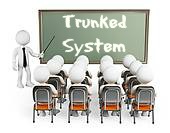
The concept of “trunking” is taken from telephone company technology and practice. It refers to the sharing of common “resources” among a number of different users on the same system without overhearing or interfering with each other’s conversations. A Trunked system takes advantage of the probability that in any given number of user units, not everyone will need “resources” access at the same time. Therefore with a given number of users, fewer discrete “resources” are required.
In a trunked radio system, the system logic automatically selects the physical radio frequency channel (the resources) without user interference. There is a protocol that defines a relationship between the radios and the radio network which supports them. The protocol allows channel assignments to happen automatically. This arrangement allows multiple groups of users to share a small set of actual radio frequencies without hearing the others’ conversations. Trunked systems primarily conserve limited radio frequencies and also provide other advanced features to users.
Instead of channels, radios are related by groups which may be called, groups, talk groups, or divided into a hierarchy such as fleet and sub-fleet, or agency-fleet-sub-fleet. These can be thought of as virtual channels which appear and disappear as conversations occur.
“Trunked” radio systems differ from “conventional” radio systems in that a conventional radio system uses a dedicated channel (frequency) for each individual group of users, while “trunked” radio systems use a pool of channels which are available for many different groups of users.
Systems make arrangements for handshaking and connections between radios by one of these two methods:
If all physical channels are busy, systems include a protocol to queue or stack pending requests until a channel becomes available.
Category: LEARNING CENTRE
Tags: Trunked, Trunked Radio, Trunked System